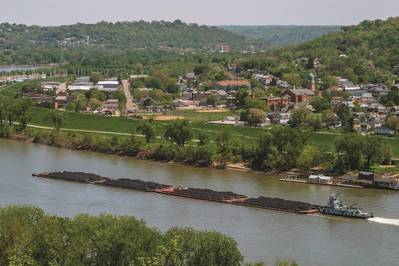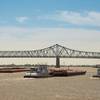The Unsung Benefits of the Inland Waterways
With developments in the current health crisis almost entirely consuming nearly all news reporting, one could be forgiven for thinking that the members of Congress are thinking about and working on little else, and that even if they were, the divisive partisanship of recent years would doom the prospects of much else getting done. Happily, that is not the case for the nation’s inland waterways. Both houses of Congress are diligently working on maintaining the momentum of passing a Water Resources and Development Act (WRDA) every two years, trying not to break stride after passing such legislation in 2014, 2016, and 2018 with large bipartisan majorities.
The work on a Water Resources and Development Act for 2020 has provided yet another occasion to consider a fundamental and recurring question: Who are the true beneficiaries of the nation’s inland waterways? This question is reflected in several of the things that WRDA 2020 is being asked to do, and to avoid.
At the top of the river industry’s First-Do-No-Harm List is avoiding lockage fees or other forms of user fees that would be the functional equivalent of toll booths at the locks and dams throughout the river system. For the past several years, in both the current administration and the previous one, the President’s budget has included a proposal for such fees in one form or another. The concept has a superficial appeal: why shouldn’t barge tows pay tolls to help cover the cost of maintaining the waterways that they use just as trucks and cars pay tolls to help cover the cost of maintaining the highways on which we all drive?
The river navigation industry has consistently—and thus far successfully—resisted these repeated proposals primarily with two arguments. First, the industry will point out that it does, in fact, contribute to the cost of maintaining our nation’s waterways infrastructure through the tax that is imposed on the fuel that is used by towboats on the rivers and that is paid into the Inland Waterways Trust Fund (IWTF), to support new and replacement construction and major rehabilitation of the locks and dams throughout the river system. The industry will further call attention to the fact that several years ago that fuel tax was increased by 45% at the river navigation industry’s own request.
The second major argument made by the navigation industry is that, unlike the roads and highways on which people drive, the rivers provide many benefits in addition to transporting cargo and passengers. The commercial users are the only beneficiaries of the inland waterways system who pay a user fee in the form of the fuel tax. Those beneficiaries who receive flood control, water supply, recreational, and similar benefits do not pay a fuel tax or fee to contribute to the construction or maintenance of the system providing these benefits.
Each time that the process gets underway for creating the next WRDA, the river navigation industry goes on high alert to make sure that some form of user toll is not included—or better yet, is expressly prohibited—in the legislation that is finally enacted. “We are not the only ones who benefit from the inland waterways system,” the industry says. “Let the other beneficiaries pay their fair share.”
But how can that “fair share” be quantified in dollar terms? Extensive and detailed studies have been undertaken in an attempt to do that, a prominent example of which is “Toward a Full Accounting of the Beneficiaries of Navigable Waterways,” prepared by Dr. Larry G. Bray, C. Michael Murphree, and Chrisman A. Dager of the Center for Transportation Research at the University of Tennessee, available on the website of the National Waterways Foundation. A rough estimate of what this “fair share” might be is already found in the current cost-share of projects that are financed from the IWTF of 50% from the IWTF and 50% from general revenues in the U.S. Treasury. In effect, the river navigation industry pays one-half of the project’s cost from the fuel taxes that the industry paid into the IWTF and the “public”—all other beneficiaries of the system of locks and dams—pays the other half from the general revenues in the nation’s Treasury.
In the current development of WRDA 2020, one of the major requests of the inland waterways industry is to change the cost-share for lock and dam projects financed from the IWTF to 25% from the IWTF and 75% from general revenues. This would conform to the cost-share that is currently provided for certain projects to improve the country’s deep water ports. One of the arguments made for making this change is that it would in fact make more efficient use of the funds in the IWTF by allowing work to proceed more smoothly and continuously, avoiding costly delays and cost over-runs. A prime example of this effect is the dramatic improvements that were made in the costs and schedule for constructing the Olmsted Locks and Dam by changing the 50-50 cost-share to one in which 85% of the costs were funded from general Treasury revenues and 15% from IWTF.
But it is also true that, while the deep water ports are vital points of import and export for our nation’s commerce, studies such as the one by Dr. Bray and his colleagues show that the inland waterways infrastructure provides many more benefits to the public than simply moving cargo in the stream of commerce. If the deep water ports warrant a 75-25 cost share because of their economic benefit to the nation, then it is no less so for both the economic and non-economic benefits provided by the inland waterways.
Other provisions being requested for inclusion in WRDA 2020 further reflect the extent to which the inland waterways provide benefits beyond the carriage of cargo and passengers. For example, requests have been made for changes to the process by which projects are approved for implementation by the U.S. Army Corps of Engineers (USACE).
When USACE considers a potential project for the inland waterways infrastructure, it first performs a benefit-cost analysis (BCA) to compare the economic benefits of alternative ways to carry out the project to the investment cost of those alternatives. In many cases that planning process will be done in cooperation with a local sponsor that will be involved in the project and that is hoping to achieve benefits from it that meet the special needs of the local community and local conditions. The outcome of this planning process is a Benefit to Cost Ratio (BCR), in which future benefits and costs of the project are taken into account by computing their present values using a discount rate. The discount rate for USACE to use in calculating the BCR of a proposed project is specified in Section 80 of WRDA 1974, to be adjusted annually; it is currently 2.75% for fiscal year 2020. Under current law, USACE may recommend for authorization only projects that have a BCR greater than 1.
However, in two respects the Office of Management and Budget (OMB) has imposed stricter requirements for projects to be included in the President’s annual budget proposal to Congress. First, OMB Circular A-94 requires that a discount rate of 7% be used in calculating a project’s BCR. Because of the long period of time for which the BCR is calculated, the present value calculations are very sensitive to the discount rate that is used. OMB’s higher discount rate typically has the effect of reducing a project’s BCR. Further, OMB has required that the BCR be greater than 2.5 in order to focus only on projects that generate the highest returns.
This reliance on BCR computations means that the prospects for a project to be authorized and funded depend heavily on how the benefits of the project are determined, since the costs can generally be quantified and estimated with a fair degree of confidence. In determining the BCR for navigation projects, USACE currently takes into account only the economic impact on those who use the inland waterways for navigation. Many of the other benefits that result from these projects are not taken into account. While some of these additional benefits might be difficult to quantify in monetary terms, there are certainly secondary and ancillary economic benefits that could be quantified for inclusion in the BCR calculation. Many economic impact studies are prepared that do this.
A related problem arises from the current requirement for the project alternative that has the highest net benefits (project benefits minus project costs) to be designated as the National Economic Development (NED) plan. A cost-sharing local sponsor may prefer an alternative plan, which is called the Locally Preferred Plan (LPP). The LPP might cost more or less than the NED alternative, but the LPP often places less importance on some of the benefits that are the basis of the NED plan, while instead it seeks to achieve subjective, non-quantifiable benefits that are important to the local community and for local conditions and but which the NED plan does not take into account. Under current law, the LPP is acceptable only if the local sponsor agrees to fund additional costs that are not part of the NED plan. These additional costs can be economically prohibitive for many smaller local sponsors, leaving them with a choice between a project that does not have the benefits that would be particularly useful to their local situation, or no project at all.
It is hoped that WRDA 2020 will help change current law and policy to better recognize the many benefits of inland waterways infrastructure projects.












